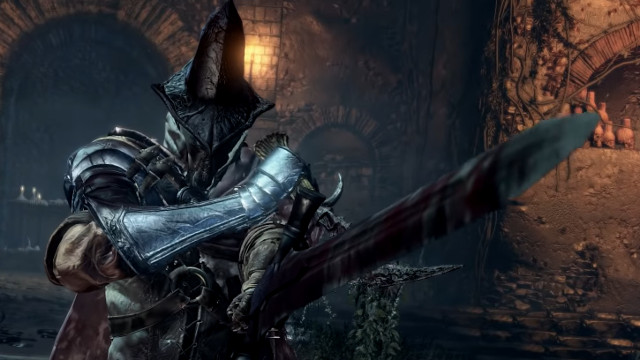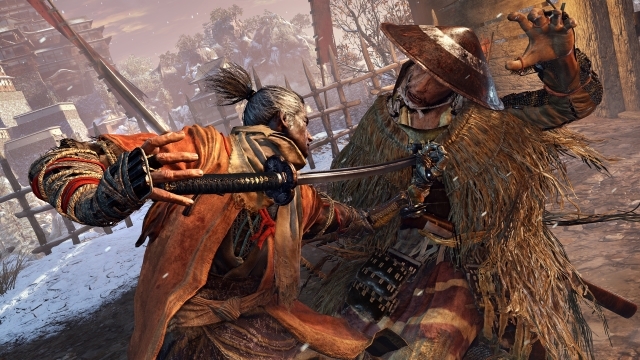The Souls series is difficult enough without having to worry about showing off. We’ve all played Dark Souls, and we’ve all had our full health bar depleted by being careless. We could play the risky game throughout the whole thing, but we all know it’s safer to put our shields up and take enemies down one at a time. So why would anyone possibly want to risk it all just to get a bit of extra damage, or an instant kill on a simple enough enemy? The parry is definitely rewarding, but it’s risky too, which is why it’s incredibly brave of From Software to make parrying an essential part of Sekiro: Shadows Die Twice.
The parry has been in the Souls series since Demon’s Souls, and over the evolution of the franchise the team has continually made it the move more and more prevalent. While your first playthrough of most Souls games likely went by without any significant use of the parry, you would learn it, and pull it out to make fights against certain bosses or tough enemies easier. But Sekiro: Shadows Die Twice teaches you the parry almost immediately and makes it clear — with overt tutorial windows, no less — that the parry is an important part of the combat here, and you should be using it in every encounter.
How Sekiro parries monotonous combat

It’s all in the off-hand, and it always has been. Since the beginning of the series, parrying has been a defensive move that you activate with your shield hand. Though, as we’ve mentioned, it feels contradictory. Why perform an action with your defensive shield that has the potential to leave you wide open? The rewards just don’t seem worth it, and parrying an enemy in Demon’s Souls or Dark Souls feels like something show-offs do exclusively in PVP invasions to enrage their fodder.
And with Bloodborne, the team wanted to change that. From took away the defensive capabilities of your off-hand and gave you a gun, which is as far away from the defensive options of the past that you could reasonably get. Players were surely a bit bemused when they first discovered that shooting enemies only ever results in a tiny amount of damage, leaving the gun better for drawing enemies from a distance. That is, unless, you get the timing just right. With perfect precision, a gunshot staggers an attacking enemy, leaving them wide open to devastating and punishing finishing moves.
But even this felt optional in Bloodborne. If you couldn’t adjust to the strict parry timing, you always just wield your primary weapon with two hands, making your attacks more powerful, at the cost of sacrificing your ability to parry. For less experienced players, afraid of the risky move, this is ideal. But Sekiro has taken away your final hiding place as you need to learn to parry now just to get through the game.
How the parry in Sekiro rewards good Posture

Those overt tutorial windows are indicative of the change here, too. From Software has never delivered training messages with these kinds of dialogue-heavy text boxes before, instead usually preferring to just set up a level where the player can uncover and use the variety of techniques at their own pace. This change of pace is here because the style of game has changed. If you go into Sekiro without being armed with the knowledge of how to play, you will come away battered and bruised.
But this isn’t quite as punishing as those other games, though. Sure, the game offers a lot of challenge, without a doubt, but this essential parry has been made a bit more accessible. The game tells players to activate the parry just as it makes contact, though it’s probably more sensible to press the button as the attack is incoming. The one-armed Wolf seems to have a large window for the use of this parry. This is good, of course, considering how intimidating it is to have to parry a boss several times in a row.
Those visceral, impactful attacks where sounds effects flare and the camera pans in for a vicious stab are still every bit as cathartic as ever, but you’ll be seeing them a lot more often. You need to attack and parry in order to lower the enemy’s posture and for mini-bosses and stronger enemies, you need that visceral killing strike, dodging and running with the odd slash to take away health is no longer enough by itself. Parrying is now a central mechanic and by forcing players to use it, From has made them engage with one of the most satisfying mechanics that carries through all of its Souls games. It’s a smart choice that makes Sekiro different from its spiritual predecessors without being completely alien.
The posture system is a fascinating evolution of classic Souls combat, forcing players to use tact in battle. It’s not to foolishly try to overwhelm opponents, but to tactfully dismantle their game plan, parrying and dodging moves with perfect precision before moving in for a finishing blow. In that sense, it’s not just the best possible use of the parry mechanic, but also the natural evolution of Souls enemy design. We’ve been memorizing boss patterns and running from their attacks for so long — now it’s our turn to anticipate each attack and punish them for it. Sekiro might not have a shield or a gun, but with Wolf’s katana and the right talent, you can feel like the most indestructible Souls protagonist yet.







